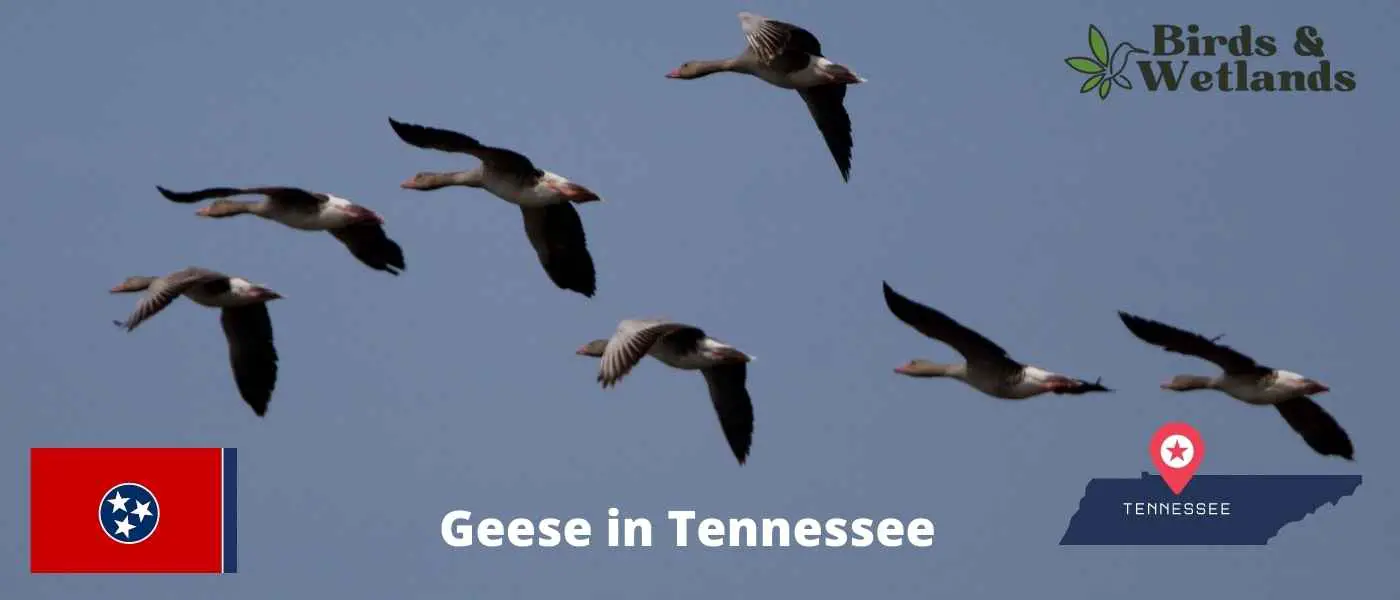If you’re a fan of nature, then you’ll love this guide to the different American geese species in Tennessee! In this guide, we will discuss where to find geese in Tennessee, what they eat, and how they interact with humans.
What type of geese are in Tennessee?
There are generally 5 types of Geese found in Tennessee, and two types of swans.
- Canada Goose
- Snow Goose
- Cackling Goose
- Ross’s Goose
- Greater White-fronted Goose
This is a similar list to the geese in neighboring Alabama and the same geese types in Arkansas, however, Georgia only have 2 types of geese whilst Mississippi Geese generally don’t have the Cackling goose.
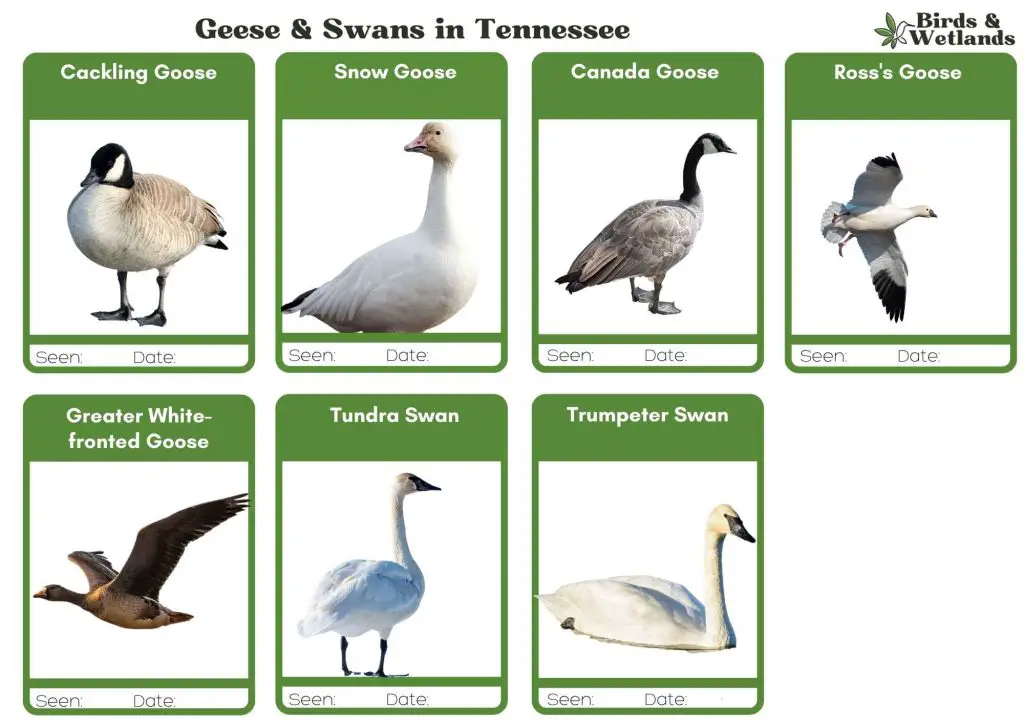
Canada Goose


Canada Goose Sound
Scientific Name: Branta canadensis
Length: 30 to 43 in
Wingspan: 50–73 in
Weight: 5.7–14.3 lb
The Canada Goose is a large, well-known species of waterfowl noted for its distinctive appearance, familiar “honk,” and migratory behavior.
Appearance: Both male and female Canada Geese have a similar appearance, featuring a black head and neck with distinctive white patches on the cheeks and chin. The body is primarily brown with a lighter, often white, underbelly.
Diet: Canada Geese primarily feed on plant matter, including grasses, aquatic vegetation, and grains. They can often be seen grazing in parks, lawns, and fields, as well as dabbling in water bodies.
Reproduction: Canada Geese typically nest on the ground near water bodies, often on islands or other isolated areas to avoid predators. The female lays a clutch of about 4 to 6 eggs, which she incubates alone for around a month.
Canada Goose in Tennesse
The Canada geese are the only resident birds, who are known to breed in Tennessee. Breeding birds can be found nesting and reproduction in Middle and East Tennessee but are rare in West Tennessee. They have a common status in Tennessee.
Snow Goose

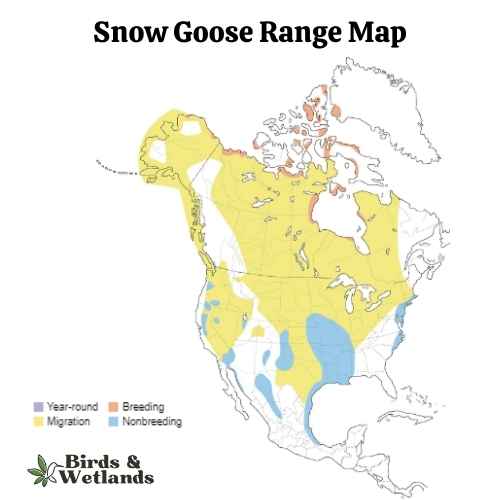
Snow Goose Sound
Scientific Name: Anser caerulescens
Length: 25 to 31 in
Wingspan: 53 to 65 in
Weight: 4.5 to 6.0
The Snow Goose is a large species of waterfowl known for its vibrant white plumage and significant migratory flights.
Appearance: True to their name, Snow Geese are predominantly white with black wingtips. They also have a pink bill, pink legs and feet. A color morph, known as the “Blue Goose,” displays a bluish-gray body with a white head, but is considered the same species.
Diet: Snow Geese primarily feed on plant matter, such as grasses, sedges, and small grains. They can often be seen in large flocks foraging in fields and marshes, and during migration and winter, they can cause considerable damage to agricultural fields due to their feeding habits.
Reproduction: Snow Geese typically nest on the tundra, near water bodies. The female builds the nest and lays a clutch of about 3 to 5 eggs, which she incubates alone for approximately three weeks. Once hatched, the goslings can feed themselves but stay with their parents for protection until they can fly.
Snow Goose in Tennesse
The Snow Goose is a common winter bird found across Tennessee, especially on state and federal waterfowl refuges in the western part. The snow goose is often called a blue goose due to its wings, but is notable by its white head.
Cackling Goose
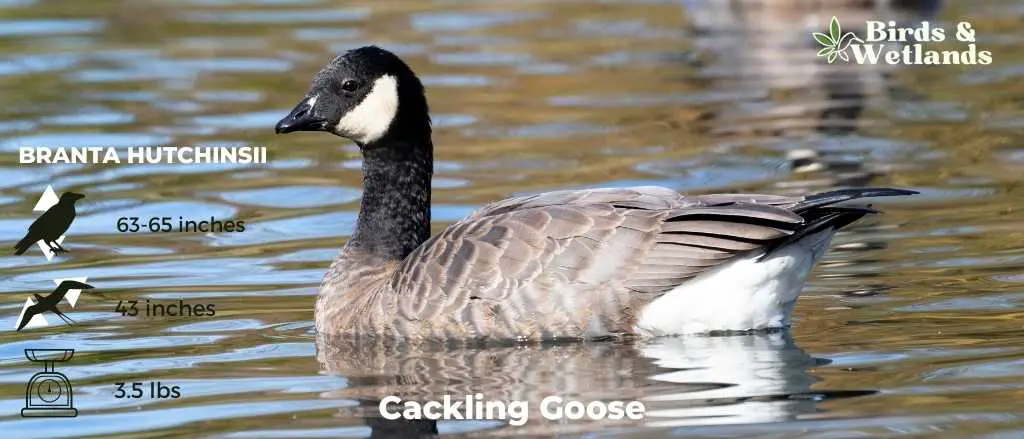
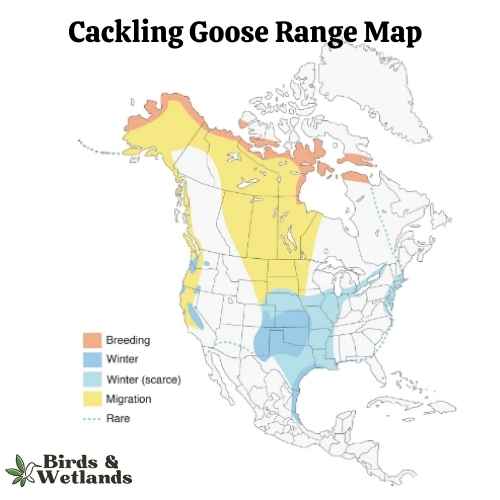
Listen
Scientific Name: Branta hutchinsii
Length: 24.8–25.6 in
Wingspan: 43-45.7 in
Weight:3.5 lbs
Cackling Geese are particularly known for their high-pitched, cackling calls, which is the source of their name. Despite their small size, these geese are renowned long-distance migrants, with some populations traveling thousands of miles between breeding and wintering grounds.
Appearance: With a similar color pattern to the larger Canada Goose, the Cackling Goose features a black head and neck, white chinstrap, light tan to cream chest, and brownish-grey body. One defining characteristic is its noticeably smaller size and stubbier neck compared to its larger counterparts.
Diet: Like many geese, the Cackling Goose’s diet mainly consists of plant matter. This includes grasses, seeds, and aquatic vegetation. They are often seen grazing on land or dabbling in shallow water.
Reproduction: Cackling Geese usually nest on the ground in elevated areas near water bodies, such as riverbanks or lakeshores. The female lays a clutch of 2 to 8 eggs and is responsible for incubation, while the male stands guard nearby. Incubation lasts for about a month.
Cackling Goose in Tennessee
The cackling goose is a rare winter bird visitor across the Tennessee state typically found in flocks of Canada Geese.
Ross’s Goose
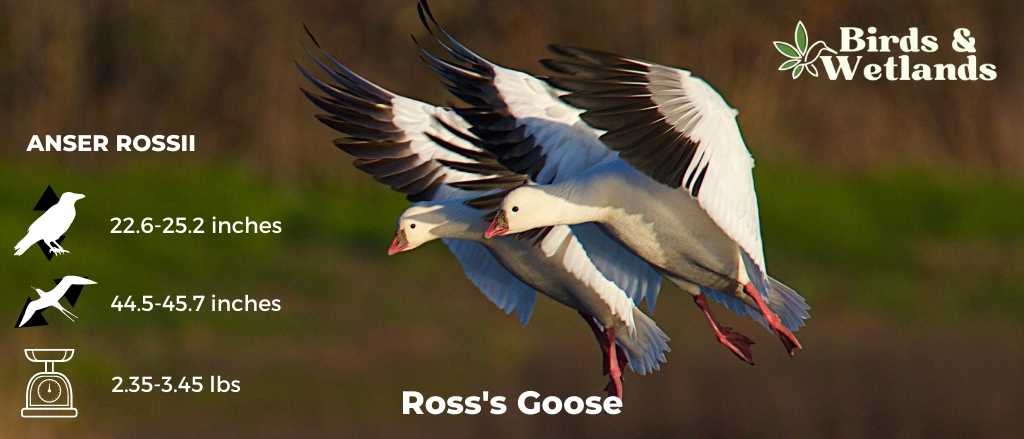
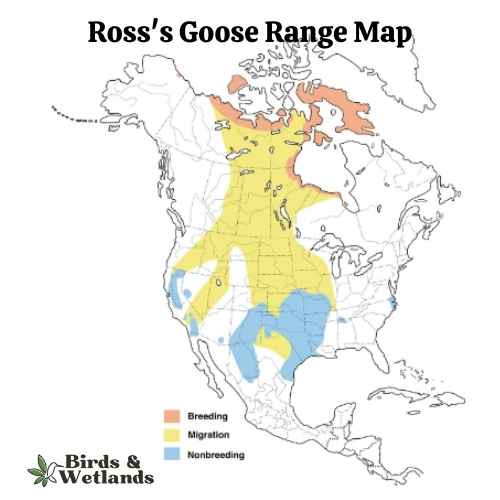
Listen
Scientific Name: Anser rossii
Length: 23.2-25.2
Wingspan: 44.5-45.7 in
Weight:42.3-55.3 oz
The Ross’s Goose is a small species of waterfowl often found in North America’s tundra and wetland habitats.
Appearance: Known for its compact size, the Ross’s Goose is mostly white with black wingtips. It features a short, stubby bill and a rounded head. One key identifying feature is the blueish gray base of its bill, which has a warty structure during the breeding season.
Diet: This goose feeds mainly on vegetation, including seeds, leaves, and roots of grasses and sedges. During winter and migration, they also consume grains and seeds from agricultural fields.
Reproduction: The Ross’s Goose nests on the ground, often in colonies. The female lays a clutch of 2 to 5 eggs which she incubates for around three weeks. The young geese, known as goslings, are precocial – they can walk, swim, and feed themselves shortly after hatching, although they stay with their parents until they learn to fly.
Ross’s Goose in Tennessee
The Ross’s Goose is a beautiful bird that can be seen all across Tennessee. You’ll find them along the Mississippi River Valley in winter and Reelfoot Lake.
Greater White-fronted Goose
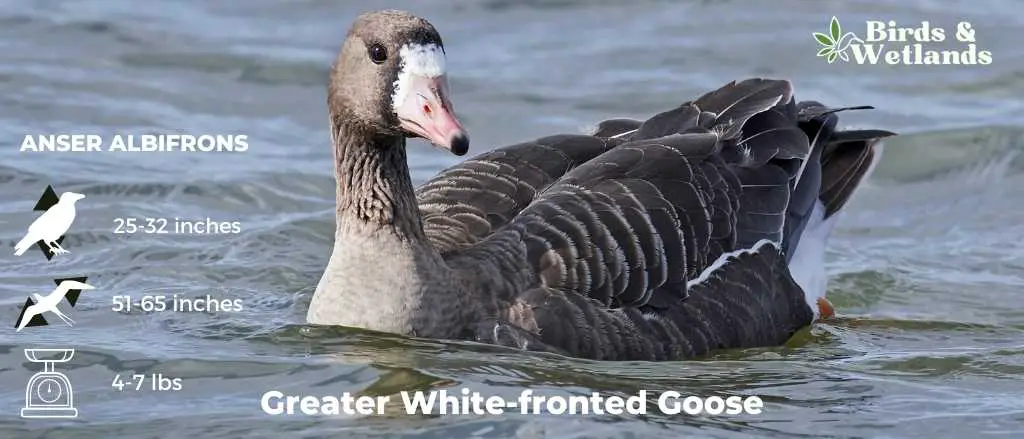

Listen
Scientific Name: Anser albifrons
Length: 25 to 31 in
Wingspan: 53 to 66 in
Weight: 3.3 to 6.6
The Greater White-fronted Goose is a medium to large waterfowl species, widely distributed across the Northern Hemisphere, particularly in North America.
Appearance: As the name suggests, these geese display a prominent white patch at the base of their bill. Their bodies are gray-brown, and their breasts are often marked with dark blotches. They possess a pinkish bill and orange legs and feet.
Diet: The Greater White-fronted Goose is a herbivore and feeds mainly on plant material. Its diet consists of grasses, sedges, grains, and berries. When wintering, these geese can often be found in agricultural fields, feasting on leftover grains and crops.
Reproduction: This species nests on the ground, often in areas with good visibility such as slopes or ridges. The female lays a clutch of 4 to 5 eggs, which she incubates for nearly a month. Once hatched, the young ones are taken care of by both parents until they are able to fly.
Greater White-fronted Goose in Tennessee
The best place to find these in Tennessee is at one of the federal wildlife refuges, such as Reelfoot Lake and Britton Ford Unit of Tennessee NWR as they feast on the aquatic vegetation.
Fun facts about the Greater White Fronted goose is that they mate for life and will often be found in flocks of other species of geese. The american ornithologists union has classified the Greater White Fronted goose as least concern.
Can you hunt geese in Tennessee?
Yes, though you will need a hunting licence and be aware of the hunting season and bag limits. All the up-to-date Tennessee geese hunting regulations can be found here.
Where are geese most commonly found in Tennessee
While geese can be found all over the state, there are certain areas where they are more commonly seen. In East Tennessee, geese can often be seen at Douglas Lake and Cherokee Lake. In Middle Tennessee, Percy Priest Lake is a good spot for bird watching. And in West Tennessee, Reelfoot Lake is a popular destination for both geese and bird watchers alike!
Take Away on Geese Species in Tennessee
Geese are fascinating creatures that can be found all over Tennessee. In this guide, we have discussed their habits and where to find them. We have also provided some fun facts and a free printable checklist of the birds. A complete list of which birds of North America can be found in Birds of Tennessee, by Tennessee press.

Jim Addison is an avid bird watcher and has been obsessed with the activity since he was a young boy.
He has traveled all over North America in search of new and interesting species to observe, and his detailed knowledge of the subject makes him a sought-after expert on the topic.

